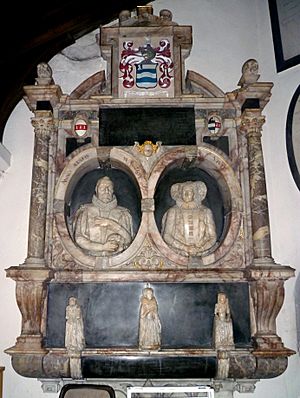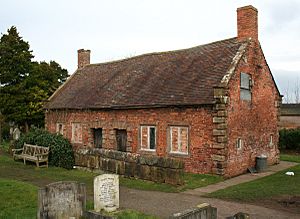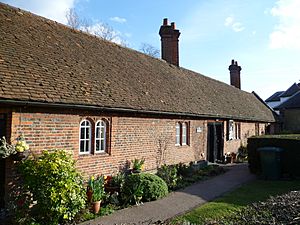Roger Wilbraham facts for kids
Sir Roger Wilbraham (born November 4, 1553 – died July 31, 1616) was an important English lawyer. He worked for Queen Elizabeth I as the Solicitor-General for Ireland. People thought he was one of her best legal advisors. Later, he held several jobs for King James I. These included being a Master of Requests and a surveyor for the Court of Wards and Liveries. He bought land in Dorfold, near his hometown of Nantwich in Cheshire. Sir Roger was also very active in helping people. He started places called almshouses for poor men in Nantwich, Acton, and Monken Hadley, where he is buried.
Contents
Sir Roger's Life Story
Roger Wilbraham was born in Nantwich, Cheshire, in 1553. He was the second of four sons. His father was Richard Wilbraham, and his mother was Elizabeth Maisterson. The Wilbraham family was well-known in Cheshire for a long time. Roger's daughter Elizabeth later married into the main part of the family.
His father, Richard, worked for Queen Mary I. He also collected money for the queen in the Nantwich area. In 1580, Richard built a house called Townshend House in Nantwich. King James I even stayed there when he visited the town in 1617. Roger's mother's family, the Maistersons, was one of the most important families in Nantwich.
Working as Solicitor-General for Ireland
Wilbraham went to Shrewsbury School and Cambridge University. He became a barrister, which is a type of lawyer. He joined Gray's Inn in London in 1576.
On February 13, 1585, he got the job of Solicitor-General for Ireland. He held this job for 17 years. He hoped it would help him get an even bigger job in England.
During his time in Ireland, some judges were known for being unfair or arguing a lot. Before Roger arrived, one judge was even put to death for a very serious crime against the Queen. Roger thought that if a judge usually did a good job for the Queen, they should not be punished too much, even if they sometimes made mistakes.
Roger himself did a great job for the Queen. In 1597, the Queen's advisors in Ireland praised him. They said he worked harder than all the other legal officers. He helped the Queen collect more money. Even though he earned a lot himself, people at the time did not see this as wrong. He was known for being very good at his job. When the main lawyer for Ireland was not working, Roger handled both their jobs very well. In his last years as Solicitor-General, he spent most of his time in England. He was building up his legal work there.
Later Career and Parliament
In 1600, while still a Solicitor, he became the Master of Requests. He kept this job under King James I. He also worked as a surveyor for the Court of Wards and Liveries. He wrote in his journal that King James becoming king meant a lot more work. This was because so many people asked the king for favors. He finally left his Solicitor job in 1603. He was chosen to be a member of Parliament for Callington in 1604. Then, in 1614, he became a Member of Parliament for Cheshire.
He had the support of Robert Cecil, an important government official. Cecil knew Roger had served the Crown well in Ireland. Roger supported the idea of joining England and Scotland into one country. He also supported Cecil's plan to help the King's money problems, though he wasn't very excited about it. He wrote in his journal that many in Parliament did not like this plan, and it failed. He was made a knight before 1613. He kept a journal from 1593 until he died. This journal shows he was a smart observer of politics, even if he wasn't a main political leader himself. He also worked in the salt-making business in Nantwich.
Family Life
He married Mary Baber in 1599 or 1600. Mary was the daughter of Edward Baber, who was also a Member of Parliament. Mary's mother was Katherine Leigh. Roger and Mary had three daughters: Mary, Elizabeth, and Catherine. After Roger died, his wife Mary married Sir Thomas Delves. She passed away in 1644.
Roger bought the Dorfold estate near Nantwich in 1602. Soon after, he gave the land to his youngest brother, Ralph. Ralph then built the beautiful Dorfold Hall there between 1616 and 1621.
Sir Roger died on July 31, 1616, in Monken Hadley, Middlesex. He died from a fever, probably malaria. He is buried in Monken Hadley. A special monument was put up in the Church of St Mary the Virgin, Monken Hadley in 1616 to remember him and his family. It cost £80. It has statues of Roger and his wife, and figures of their daughters.
His three daughters inherited a lot of money, about £4000 each year. Mary married Sir Thomas Pelham. Elizabeth married her distant cousin, Sir Thomas Wilbraham. Catherine married Sir Henry Delves, who was the son of her stepfather, Sir Thomas.
Helping Others: Charitable Works
In 1613, Sir Roger started Wilbraham's Almshouses to help six poor men. These were in Nantwich and were the first almshouses in the town. In the same year, he also started almshouses for two poor men in Acton. He also gave £4 to be given to the poor of Nantwich every year on Good Friday. He also helped people in Monken Hadley. In 1616, he founded almshouses there for "six decayed housekeepers," meaning people who had lost their homes or jobs.







